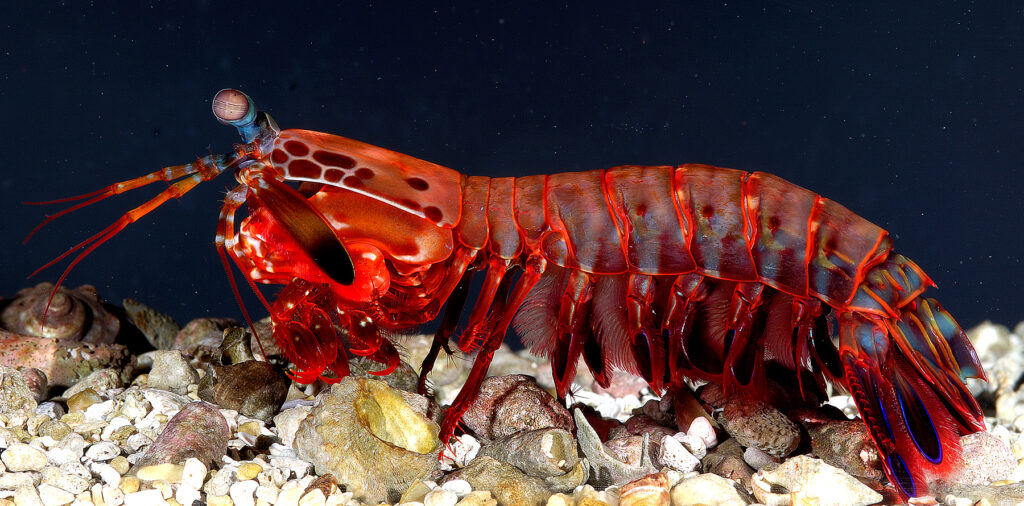
Mantis shrimp (Public Domain)
WASHINGTON: Faster than a speeding bullet. Able to crack snail shells or kill an octopus with an unbelievably fast snap. OK, it’s not Superman; maybe Super-Shrimp?
The Army, funding Harvard and Duke university researchers, appears to have cracked one of nature’s mysteries — how the small (less than four inches) mantis shrimp can whack enemies and food incredibly quickly and with great force even though it’s tiny and doesn’t have big muscles. The Army believes it can harness this mechanical marvel.
Basically, Army-funded scientists were able to use ultra-high speed photography to break down what happens. Turns out the mantis shrimp is sort of a brilliant spring.
Here’s the Army’s remarkably lucid explanation of how it works:
“Many small organisms, including frogs, chameleons, and even some kinds of plants, produce ultra-fast movements by storing elastic energy and rapidly releasing it through a latching mechanism, like a mouse trap. In mantis shrimp, two small structures embedded in the tendons of the muscles called sclerites act as the appendage’s latch,” a release about the research explains. “In a typical spring-loaded mechanism, once the physical latch is removed, the spring would immediately release the stored energy, but when the sclerites unlatch in a mantis shrimp appendage, there is a short but noticeable delay.”
“There is obviously another mechanism holding the appendage in place, but no one has been able to analytically understand how the other mechanism works,” writes Nak-seung Hyun, a postdoctoral fellow at Harvard’s John A. Paulson School of Engineering and Applied Sciences and co-first author of a research paper on the shrimp’s uncanny speed and power. “It is as if a mouse triggered a mouse trap, but instead of it snapping right away, there was a noticeable delay before it snapped.”
So the researchers built a model to try and explain how it worked. They discovered the shrimp’s design or natural architecture basically functions as a delaying factor, which appears to help accelerate the snapping action. Biologists had hypothesized that this was true. The appendage’s shape acts as a secondary latch, controlling the arm’s movement while it continues to store energy, the release explains. They were able to build a model to to replicate this action.
Testing the robotic model they found that, indeed, after the sclerites unlatch, the geometry of the mechanism takes over, holding the appendage in place until it reaches an over-centering point and then the latch releases.
“These pugnacious crustaceans could pave the way for small, but mighty robotic devices for the military,” says the release from the Army Combat Capabilities Development Command Army Research Lab.
“The idea of a loaded spring released by a latch is a staple in mechanical design, but the research team cleverly observed that engineers have yet to achieve the same performance out of a Latch-Mediated Spring Actuator that we find in nature,” Dean Culver, program manager at the lab, writes in an email. “By more closely mimicking the geometry of a mantis shrimp’s physiology, the team was able to exceed accelerations produced by limbs in other robotic devices by more than tenfold.”
Here’s how:
What might some real world applications be?
“One of the easiest examples to imagine is a jumper. Jumping is an extremely difficult task for conventional actuators to accomplish because a great jump comes from a lot of energy being released all at once in a very controlled manner. That sudden-yet-targeted burst is a real engineering challenge,” Culver told Breaking Defense. “Another application is throwing. That’s the other ‘sudden’ task that would be useful for robots. It’s a motion that, once again, benefits from releasing a ton of energy in a short time. That time window is short enough that conventional actuators aren’t very efficient in a lot of instances.”
While combining these incredibly fast bursts with a leg-like mechanism could produce something able to leap tall buildings in a single bound, it also poses a very complicated control problem, Culver said, adding that boosts in computational speed could lead to a mad jumping robot in “coming decades.”
The research on all this originally appeared in the Proceedings of the National Academy of Sciences.
‘AI-BOM’ bombs: Army backs off, will demand less detailed data from AI vendors
Instead of demanding an exhaustive “AI Bill of Materials.” the Army will only ask contractors for a “baseball card” of key stats on their AI — while building up its in-house capacity to check for bad code or “poisoned” data.



























